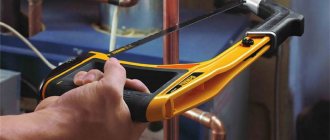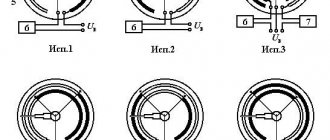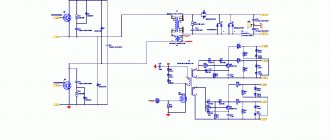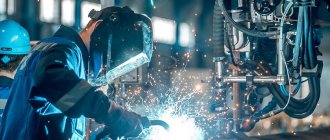The plasma welding machine, which until recently was considered a novelty, is now confidently replacing the position of electric welding machines. Moreover, with the advent of increasingly compact plasmatrons, this “epidemic” from the industrial sector spread to the household sector. At the moment, approximately 65% of problems traditional for electric welding are solved using a plasma welding machine.
Assembly of metal structures, installation of pipelines, cutting and welding of workpieces in mechanical engineering, especially from such “indigestible” materials as special alloys, stainless steel and non-ferrous metals – these are just part of a large list of tasks that have to be solved using plasma equipment. But the plasma torch, unlike electric welding, can also work with non-metals. With its help, for example, the surface of reinforced concrete products is melted - an excellent alternative to waterproofing.
- A little about this device
- Types and features of application
- Popular models and manufacturers
Operating principles of a plasma welding machine
To deeply understand the question of what this tool is intended for, you need to carefully study the features of its design and basic functioning.
As a rule, this weapon consists of several parts, including:
- Burners, that is, plasmatrons. Their designs are very complex, and all because this is the main element of the entire system. It is here that plasma is created, with the help of which welding occurs. The main parts of the burner are the pipeline through which gas and coolant are supplied, electrical cables through which current is supplied and operating voltage is created.
- Power supplies (inverters). From the name it is clear that this part is responsible for supplying electrical voltage to the equipment.
- Cylinders with plasma-forming gases. It should be noted that plasma is created precisely under the influence of oxygen, argon and nitrogen.
- Protective gas cylinders. Since welding is a rather dangerous activity, the presence of special gases was provided that would protect the weld pools. Inert gases are used here, that is, nitrogen, argon, alcohol vapor and acetone.
- Water cooling systems. To reduce the welding temperature, a special coolant is used, which is supplied through special tubes. They are the ones who make up this entire system.
- Cable packages. Of course, such devices are very demanding on the supply of electrical energy, so a high-quality device contains several cables. There are tubes supplying working and shielding gas, supplying coolants, cables that are responsible for supplying the bulk of the current, cables that are responsible for starting plasma arcs and the control circuit system.
In general, you can understand that the design of such a device is very complex and a beginner will not be able to understand each element on his own. Therefore, if you have questions, it is best to contact specialists.
About the process in brief
The energy source in this type of welding is a plasma flow generated by a torch made of a tungsten electrode, nozzles and pipes supplying gas and water to cool the workpieces. Such devices are called plasmatrons.
A gas (usually argon, oxygen, nitrogen or air) is introduced into the arc zone, heated and ionized. If a conventional electric arc reaches a temperature of 7000 degrees, then a plasma arc reaches 30,000 degrees. The thermal expansion of the gas, leading to an increase in its volume by 50-100 times, coupled with the kinetic energy of the particles, forms a plasma flow.
Types of plasma welding machine
Due to its high popularity on the market, the device was refined and improved from year to year. For this reason, many models and varieties of the unit have appeared.
There are several parameters by which this tool is classified.
According to combustion methods, they are usually divided into:
- Direct action devices. This is the most popular model, because here the functioning process occurs with the help of electrodes. And the plasma arc is created directly in the gaps from the electrode to the part being welded.
- Devices of indirect action. A less common type that has the ability to regulate plasma action. This procedure occurs by regulating the supply of gases.
Based on capacity indicators, we can distinguish:
- A tool that operates at low current levels. A current of up to twenty-five Amperes is used here.
- A unit that operates at medium power (up to one hundred and fifty Amperes).
- Devices operating at high power levels. These are professional welding units that use a current exceeding one hundred and fifty Amperes.
Advantages of plasma welding equipment
These include:
- high process temperature, allowing to obtain results in a short time;
- smaller arc diameter (affects work accuracy);
- no need to purchase gas cylinders;
- It is enough to use glasses, not a welding helmet;
- arc stability;
- accuracy of seam geometry;
- work in manual or automatic mode;
- the flow directed to the workpiece does not lead to its movement and warping;
- reliability during one-sided welding (allows you to connect sheet metal to large structures and weld hard-to-reach places).
Gas-flame welding equipment is in demand in areas where the raw material is rolled sheet metal. These are the food and chemical industries, mechanical engineering, energy, electrical engineering, and production of switchboard equipment. Next, we invite you to familiarize yourself with well-known manufacturers and consider popular installations for plasma welding.
By what characteristics to choose
For a high-quality and correct selection, you should consider those characteristics that will greatly affect the operation of the entire unit. This list includes:
- Power supplies. Here you have the opportunity to choose a tool with a transformer and inverter type of power supply.
- Methods of electrical connections. You can choose a device with contact and non-contact types.
- Types of ignitions. There are models on the market with contact-type ignitions, pneumatic and high-frequency.
- Types of cooling system. There are air or liquid cooling systems.
- Type of welding. You have the opportunity to choose a device that works using conventional and non-consumable electrodes.
- Type of control. There are automatic and manual controls.
- Indicators of service life.
- Price.
Of course, it is worth understanding that the choice of such a tool should be based on the purpose and scope of application.
Types of equipment
Various models of plasma welding and cutting machines can be classified according to several criteria - operating principle and power.
By power:
- Devices with current from 0.1 to 20 A: This type of material processing is called microplasma. Such devices are most widespread.
The simplest microplasma devices operate only in the continuous arc mode. More functional versions support pulse mode. The capabilities of such a device can be used more flexibly: the pulse mode allows you to reduce the temperature in the welding zone, which is necessary in certain cases (when working with thin-sheet workpieces, for example).
- Devices with current strength from 20 to 100 A: In terms of its capabilities, plasma welding at medium currents approximately corresponds to argon-arc welding, for which tungsten electrodes (non-consumable) are used.
- Devices with a current of over 100 A: Installations of this class are capable of melting through a workpiece of almost any size, creating a strong, uniform seam throughout the entire thickness of the parts in one pass.
Based on the operating principle:
- Plasma-arc devices: The material being processed is exposed to a directed flow of hot ionized gas.
- Air-plasma machines: The function of these machines is exclusively to cut the workpiece. The material melted by the plasma is blown out of the cutting zone by a jet of compressed air.
Finally, plasma equipment can be designed for manual or automatic work.
Pros and cons of a plasma welding machine
Experts have studied this instrument inside and out. Therefore, they identified several advantages, including:
- Fast and high-quality welding and cutting process.
- Compatible with many types of metals.
- Ensuring high precision work.
- Low danger.
- Quite easy to use.
And the list of disadvantages includes:
- Inability to work with metals that have a thickness of more than one hundred millimeters.
- Inability to connect two burners to one unit.
- High demands on the availability of powerful and stable electrical networks.
Features and characteristics of the process
To understand what plasma welding is, it is worth considering its important features, namely how the process is carried out. During it, a very high temperature is usually applied in the welding area, which is formed by a forced reduction in the cross-sectional dimensions of the arc and an increase in its power indicators.
The result is plasma jet welding, in which temperatures can reach up to 300,000C. But with argon arc welding they can be only 5000-70000C. During the welding process, the arc takes on a cylindrical shape, which is what allows it to maintain the same power rating along its entire length.
During plasma welding, high arc pressure is observed on the surface of the metal elements being welded. This is what makes it possible to influence almost all types of metals and alloys.
It is worth noting! Plasma welding technology can be used with small amounts of electric current. The process can be carried out at 0.2-30 A.
All these features make this type of welding almost universal. It can be successfully used in hard-to-reach areas when connecting thin aluminum sheets without possible burns. A slight change in the distance between the electrode and the workpiece does not have a strong effect on heating, which means it does not affect the quality of the seam, as happens in other types of welding.
Due to the fact that during plasma technology a large depth of heating of parts is observed, this makes it possible to do without preliminary preparation of the edges. It is allowed to weld metals with non-metals.
As a result, there is an increase in work productivity, a decrease in the temperature deformation of the welded joint, which means that the structural part does not behave. But welding with a plasma cutter allows not only welding of metal structures, but also ensures high-quality cutting of metals and non-metals in different positions.
Plasma Welding Machine Manufacturers
There are a lot of high-quality and not so good brands on the market.
To avoid purchasing a low-quality product, pay attention to:
- ESAB - Sweden.
- Blueveld - Italy.
- Telvin - Italy.
- Grovers - Russia.
- Fubag – Germany.
- Aurora - China.
- FoxWeld - Italy.











